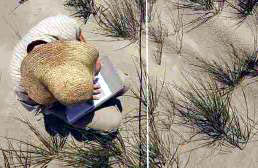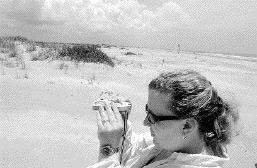  |
Monday, July 28, 2003 7:46AM EDT
When every plant counts
|
|||
By BARBARA BARRETT, Staff
Writer
BIRD ISLAND -- The sun rose
high and hot, and Kristen Rosenfeld knelt in long pants and a long-sleeve shirt
next to a spriggy little green plant, making notes on a clipboard and having, it
seemed, the time of her life.
"Cakile edentula ," she said. "Which is commonly called sea
rocket. Which is a really cool plant." She paused. "It's an herb."
Rosenfeld likes learning, and she likes teaching, and she loves the idea of
conserving a natural resource threatened by development.
For two summers, Rosenfeld has been methodically charting and counting flora
on the southeastern tip of North Carolina. Her work will help the state
understand how to protect its newest coastal reserve, bought just last year for
$4.2 million. The tally also is part of an experiment much larger than herself.
A 25-year program, involving dozens of scientists and volunteers, is aimed at
surveying all the plants throughout the Carolinas.
What a great master's project.
"I'm all for knowledge for the sake of knowledge," said Rosenfeld, who is
working on an advanced degree in botany from N.C. State University. "I think
it's grand. But personally, I wanted whatever I do for my master's work to be
practical as well."
Two years ago, Rosenfeld spread out an aerial map of Bird Island and started
charting one-centimeter grids. She numbered each and asked herself: Are these
grasslands? Dunes? Marshes? Thickets?
She divided them into four piles, tossed the numbered papers into a bucket
and pulled the numbers out randomly. These would be her plots, more than 100 in
all.
For weeks at a time, Rosenfeld hoofed out to uninhabited Bird Island from
nearby Sunset Beach, weighed down with equipment. Often she had volunteers in
tow -- other students or, once, members of the N.C. Wildflower Society.
She measured out 10-meter-by-10-meter plots and, carrying her clipboard,
listed each plant species and how much of it she saw.
She wrapped up her last plot about a week ago .
It's this quantitative count that is so unusual for plant surveys, said Tom
Wentworth , an NCSU botany professor and chairman of Rosenfeld's graduate
advisory committee.
Wentworth is among a group of vegetation scientists who decided back in 1988
that the Carolinas needed an all-encompassing survey of their ecologi-
cal habitats and the plants that live there.
The group developed a strict protocol of plot-charting and counting that is
used by every researcher and volunteer who ventures into the woods or through a
meadow.
When Rosenfeld's work is done, her project and data analysis will join the
wealth of information.
"All of our data is collected from permanent plots that we've established and
can be revisited in the future," Wentworth said. "If people want to look at
change in time in these natural communities, they can do that.
"That makes it special. It also makes it an enormous amount of work."
He thinks the Carolina Vegetative Survey, as it's called, could take another
decade to complete.
Plotting the plants
One afternoon earlier this summer, Rosenfeld trooped across the beach and cut
inward to a point among the dunes.
She was joined by Emily MacFadyen , another graduate student at NCSU who
volunteered to help.
Rosenfeld raised a measuring stick in her right arm.
"Okay, let's do a 10-by-10 plot. Let's corner it right here."
Together, the women squared off the plot, with MacFadyen clambering up the
dunes and picking through the sea oats to plant her stakes.
Compared with the lush environments of the mountains or savannahs, this plot
looked pretty sparse. A little sea rocket, some sea oats, a thinner grass called
Spartina patens.
"There are not many plants that can make a living on the beach," Rosenfeld
said as she jotted notes.
"Between the wind, and the sand is very, very nutrient-poor and it doesn't
hold water, and the plants must be tolerant of drought and sea spray and
occasionally of salt water coming up -- "
She stopped to explain that her next step was to count the plant cover.
"-- That's why there's so few species in this environment. It's pretty
harsh."
Rosenfeld has walked all 150 acres of the uplands on Bird Island and waded
through much of its 1,200 acres of wetlands. Sometimes she calls it "my island."
A change in beaches
Rosenfeld, who is 33, moved to North Carolina with her family when she was 7
years old. As a child she played in the waves of the Atlantic Ocean, but she
also grew up watching homes and businesses spring up on the barrier islands.
"There's not a lot of natural areas left," she said. "We've just sort of
changed the nature of beaches. We've stabilized them. Barrier islands are not
stable things, but we've made them so."
She went to school at Appalachian State University, earned a degree in
political science and considered law school, thinking that someday she would be
shaping public policy in Washington, D.C.
That background makes a difference now, she said.
She understands how science gets turned into government attitudes. She knows
how to make her conservation research matter to state and federal agencies.
"You can have all the facts you want," she said. "But if those facts don't
get turned into useful public policy, they don't help."
She has also learned a bit about the practical side of science.
She had to get research permits and wade through funding applications. She
received a $5,000 grant from North Carolina Sea Grant, a federal/state agency
that promotes education and research along the coast.
Two years into her project, Rosenfeld is surprised more by what she didn't
find than by what she did.
She expected some maritime forest, the woods that are characterized by live
oaks and are so common on other barrier islands. Instead, Bird Island has fewer
than a dozen trees, period, she said.
She never found a rare plant called the seabeach amaranth. She led a group of
federal officials and volunteers in reintroducing some of the plant on the
island earlier this summer, but those don't count.
A different view
"I've definitely learned there are lots and lots of plants out there that I
didn't know before," she said.
"I don't look at barrier islands the way I used to. I used to go to the beach
and look at the water, and now I spend most of my time looking at the interior."
Walking down the beach and away from her plot, Rosenfeld laughed at the idea
of finding a brand new species in her work.
There are maybe 200 plant species on the whole island, among them at least 15
that Rosenfeld can't identify. She took samples home, flattened them in a wooden
plant press and is now ready to embark on the hunt for their names.
Who knows? she said last week.
"There still may be some really exciting find in that stack that I haven't
encountered yet."
She's still looking.
[BACK]